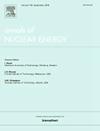Optimization of core design to achieve ultra-long core life in alternative ways for modular gas cooled fast reactor
IF 1.9
3区 工程技术
Q1 NUCLEAR SCIENCE & TECHNOLOGY
引用次数: 0
Abstract
This study explores three alternative approaches to identify the suitable core design for achieving ultra-long core life in the Allegro-50 MWth small modular gas-cooled fast reactor. The approaches considered include: the strategic use of radial blanket, the incorporation of the heterogeneous distribution of fertile and fissile materials alongside a radial blanket, and the application of a fertile material coating around the fuel region of pin cells combined with heterogeneous pin cells. Neutronics analysis was carried out using the OpenMC Monte Carlo code, and a comprehensive depletion analysis revealed that all proposed models maintained criticality for extended periods. Both the Radial model (Model 2 (R)) and the Pin Heterogeneous model (Model 3 (Pin_H)) achieved a stable effective multiplication factor after an initial decline, maintaining this stability for a century. The mass evolution of these two models also showed an increase in the inventory of the key fissile isotope (Pu-239) over time. However, this stability and ultra-long core life came at the cost of non-uniform neutron flux and power distribution at BOL, which impacted the power peaking factor, especially for Model 2 (R) and Model 3 (Pin_H). Despite this, all models maintained the power peaking factor within acceptable limits and exhibited a more uniform distribution of neutron flux and power distribution at EOL. Although the Coated Fertile Mixture model (Model 4 (Mix)) did not achieve a stable multiplication factor like the other two proposed models, it still attained a longer core life as the effective multiplication factor decreased more gradually than the reference model (Model 1 (Ref)). Additionally, Model 4 (Mix) achieved a more uniform distribution of neutron flux and power distribution. All proposed models demonstrated satisfactory beta effective values, negative Doppler constants, control rod worth, and positive shutdown margin with similar characteristics in terms of neutron energy spectra. While all three models yielded successful results, Model 3 (Pin_H) emerged as the most favorable option due to its satisfactory performance across all neutronics parameters.
求助全文
约1分钟内获得全文
求助全文
来源期刊

Annals of Nuclear Energy
工程技术-核科学技术
CiteScore
4.30
自引率
21.10%
发文量
632
审稿时长
7.3 months
期刊介绍:
Annals of Nuclear Energy provides an international medium for the communication of original research, ideas and developments in all areas of the field of nuclear energy science and technology. Its scope embraces nuclear fuel reserves, fuel cycles and cost, materials, processing, system and component technology (fission only), design and optimization, direct conversion of nuclear energy sources, environmental control, reactor physics, heat transfer and fluid dynamics, structural analysis, fuel management, future developments, nuclear fuel and safety, nuclear aerosol, neutron physics, computer technology (both software and hardware), risk assessment, radioactive waste disposal and reactor thermal hydraulics. Papers submitted to Annals need to demonstrate a clear link to nuclear power generation/nuclear engineering. Papers which deal with pure nuclear physics, pure health physics, imaging, or attenuation and shielding properties of concretes and various geological materials are not within the scope of the journal. Also, papers that deal with policy or economics are not within the scope of the journal.
 求助内容:
求助内容: 应助结果提醒方式:
应助结果提醒方式:


